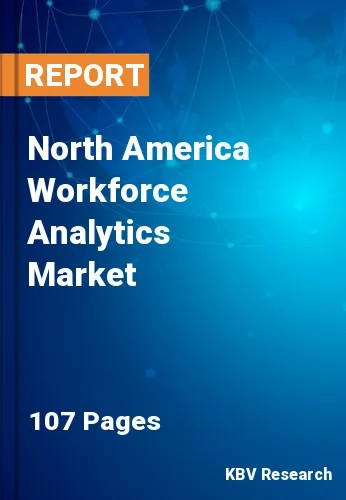The North America Workforce Analytics Market would witness market growth of 16.0% CAGR during the forecast period (2023-2029).
One of the most important kinds of workforce analytics is predictive analytics. Forecasting is the process of making predictions using historical data from the workforce. The main statistical methods used in this workforce analytics are machine learning and data mining. Several businesses use predictive workforce analytics to improve employee satisfaction and expedite procedures. Businesses typically employ regression analysis, multivariate statistics, pattern matching, and other approaches in this process to help them forecast future risks and talent outcomes.
The corporation needs adaptability, innovation, speed, and talent to set itself apart from rival businesses in today's international economy. Employee investment in workforce planning and corporate success have been given more attention because of this. Each organization's human capital is a valuable resource. Analyzing internal data on people can lead to better productivity, higher employee engagement, and lower employee turnover. In addition, with the development of technology and the expansion of international trade, management now needs to use workforce analytics to more effectively balance the needs of customers and the employee workforce.
The US is a technically advanced nation; hence a wide range of industries in the nation has a high adoption rate for cutting-edge technologies. The US is home to a wide variety of industries and is the world's leading pioneer in high technology, further encouraging the adoption of HR-based solutions nationwide. The US draws many businesses from various industries to establish their headquarters there because it is a technologically advanced nation. Also, the US government is putting a lot of effort into boosting labor productivity and efficiency by employing HRM solutions for payroll, time, attendance, and talent management in organizations, which further propels the workforce analytics market in the region.
The US market dominated the North America Workforce Analytics Market by Country in 2022, and would continue to be a dominant market till 2029; thereby, achieving a market value of $1,228 million by 2029. The Canada market is poised to grow at a CAGR of 18.7% during (2023 - 2029). Additionally, The Mexico market would witness a CAGR of 17.6% during (2023 - 2029).
Based on Component, the market is segmented into Solution and Services. Based on Vertical, the market is segmented into IT & Telecom, BFSI, Manufacturing, Retail & Ecommerce, Government, Healthcare & Life Sciences, Education, Energy & Utilities, and Others. Based on Organization size, the market is segmented into Large Enterprises and SMEs. Based on Deployment Mode, the market is segmented into On-premise and Cloud. Based on countries, the market is segmented into U.S., Mexico, Canada, and Rest of North America.
Free Valuable Insights: The Worldwide Workforce Analytics Market is Projected to reach USD 4.9 Billion by 2029, at a CAGR of 17.4%
The market research report covers the analysis of key stake holders of the market. Key companies profiled in the report include IBM Corporation, SAP SE, Salesforce, Inc. (Tableau Software, LLC), Oracle Corporation, ADP, Inc., Workday, Inc., Cornerstone OnDemand, Inc. (Clearlake Capital Group, L.P.), Visier, Inc., UKG, Inc. and WorkForce Software, LLC.
By Component
By Vertical
By Organization size
By Deployment Mode
By Country
Our team of dedicated experts can provide you with attractive expansion opportunities for your business.

